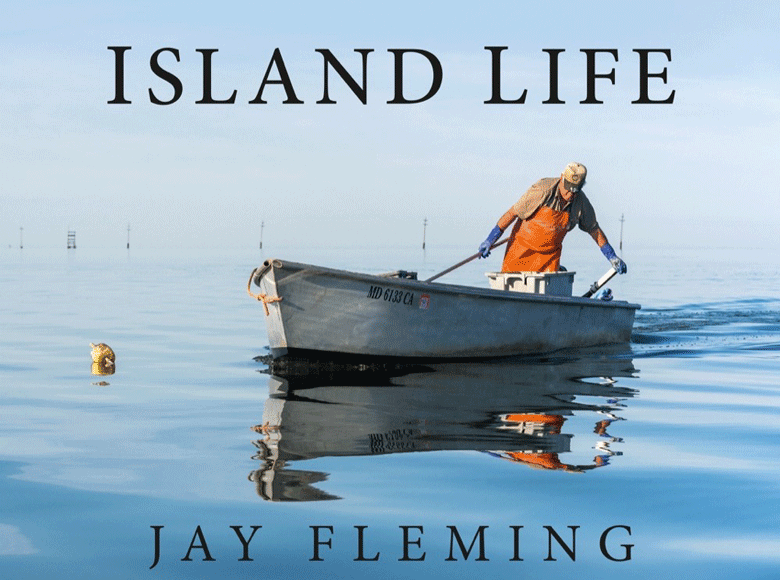Island Life
By Jay Fleming (2021)
Review by Jack Sullivan
A photobook is typically conceived to be consumed lightly, making it a great candidate to present on the coffee table. While Annapolis photographer Jay Fleming’s new book Island Life is beautiful enough to earn a place on anyone’s coffee table, it is not a light read. It requires a reader’s full immersion because it is more of an artifact than it is a photobook. It is a snapshot in time, documenting a way of life that has long existed, but is facing the threat of disappearing.
Set in the middle of Chesapeake Bay, the imagery will look familiar, even to Mainers who have never left the state’s borders. Small, close-knit communities, harvesting of shellfish, and cultures built around the sea all paint the pictures of Island Life.
Unlike the rocky shoreline of Maine’s islands and coast, Chesapeake Bay’s islands are low-lying and sandy, making them particularly vulnerable to sea level rise. Islands populated by hundreds of people around the turn of the 20th century are no longer inhabitable.
Fleming’s photographs create uneasiness; the urgency is palpable.
One powerful image that Fleming captures in Island Life is of the last house on Holland Island. At the time of the photograph, every other building on the island had either been moved or had collapsed into the sea. Six months later, the subject of the image met the same fate.
Of the dozens of once-populated Chesapeake Bay islands, the islands of Smith and Tangier are the only two that remain as year-round communities.
While the communities are portrayed as vibrant, filled with personality, and vestiges of tradition, Fleming does not balk at documenting the impending threat of an eroding coastline. He instead makes a point of doing so: dramatic portraits of islanders holding gravestones from cemeteries that have been claimed by the ocean, children playing with toy boats in their driveways, the asphalt submerged by several inches of storm surge, and inundated helicopter pads that raise questions about emergency response preparedness.
Fleming’s photographs create uneasiness; the urgency is palpable.
A reader who understands the fundamentals of climate change will instantly target the source of the urgency, but at no point does Fleming play the role of explicit “activist.” In fact, the phrase “climate change” only appears in the book once. Instead, Fleming chooses to play the role of observer and documenter.
This photobook does not feel like its primary purpose is to inspire me to reduce my carbon emissions. Instead, it feels like a document that is meant to memorialize the island communities and their culture. But for me, it succeeds at both.
Because Fleming has been visiting the islands frequently and for many years, he was uniquely suited to tell their story. Some of the settings he immerses the reader in are truly intimate. An image comes to mind of a woman picking crab meat in her home kitchen while her husband relaxes in his recliner next to an American flag adorned Christmas tree.
It is evident that Fleming and his subjects are well acquainted, if not friends, and it makes the reader feel for a moment as if they are part of the community.
There’s also an entire section of the book dedicated to the wildlife of the bay, so beyond the powerful human-interest story and dramatic tale of sea level rise, Island Life also illustrates the nature of the region. It is complete with macro images of newborn pelicans and underwater shots of feisty blue crabs.
The context of the photography in Island Life makes it far more valuable than just its beautiful imagery. Tangier and Smith islands appear to be special to Fleming for their culture first, and their beautiful scenery second. If the trends of erosion continue, it is possible these communities will follow the same fate of Holland Island.
Fleming achieves what a true documentarian would, and he does it well, capturing people working, living, playing, eating, and praying in the present day—no matter how uncertain the future looks.
Jack Sullivan is a multi-media storyteller with the Island Institute, publisher of The Working Waterfront.





